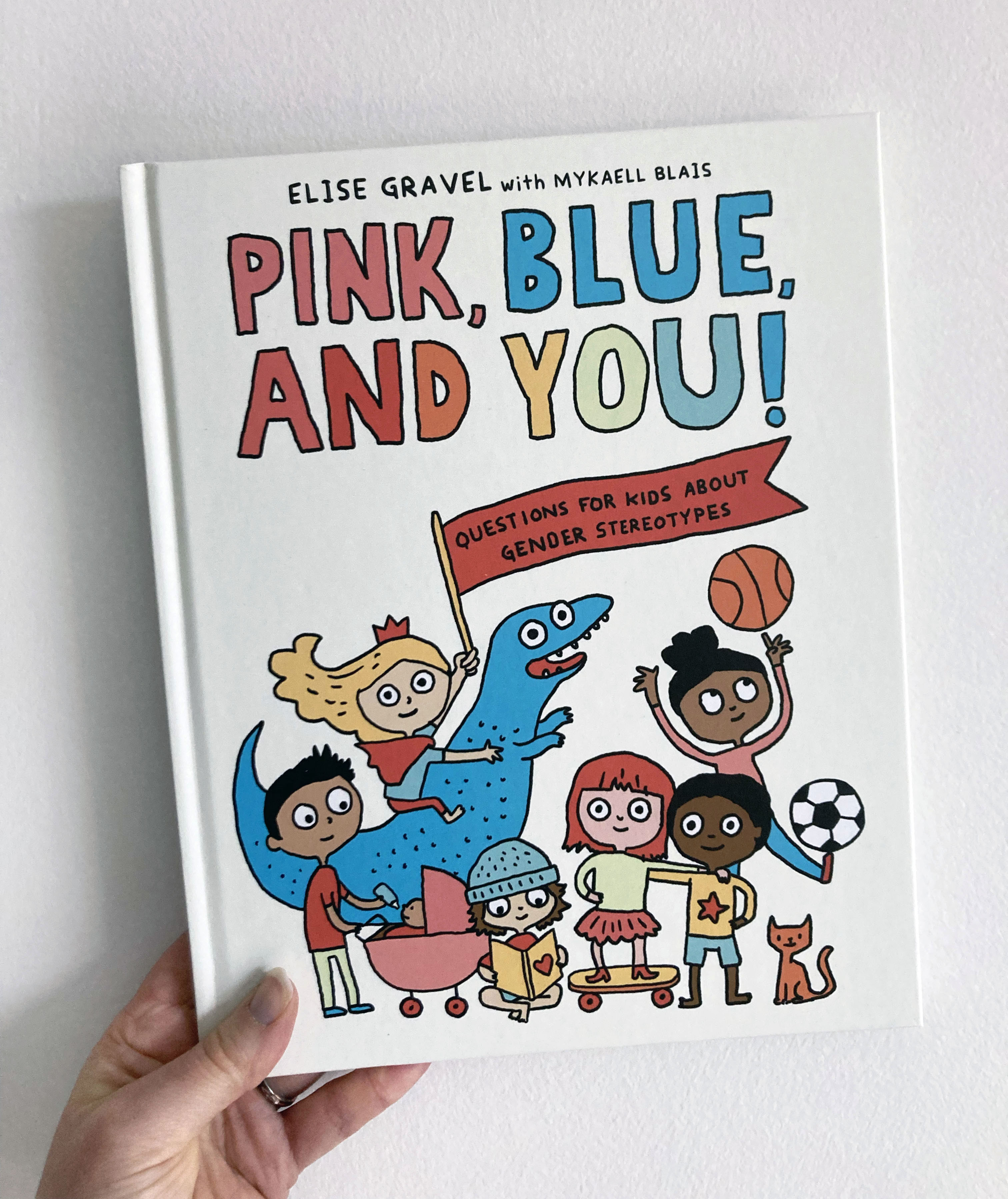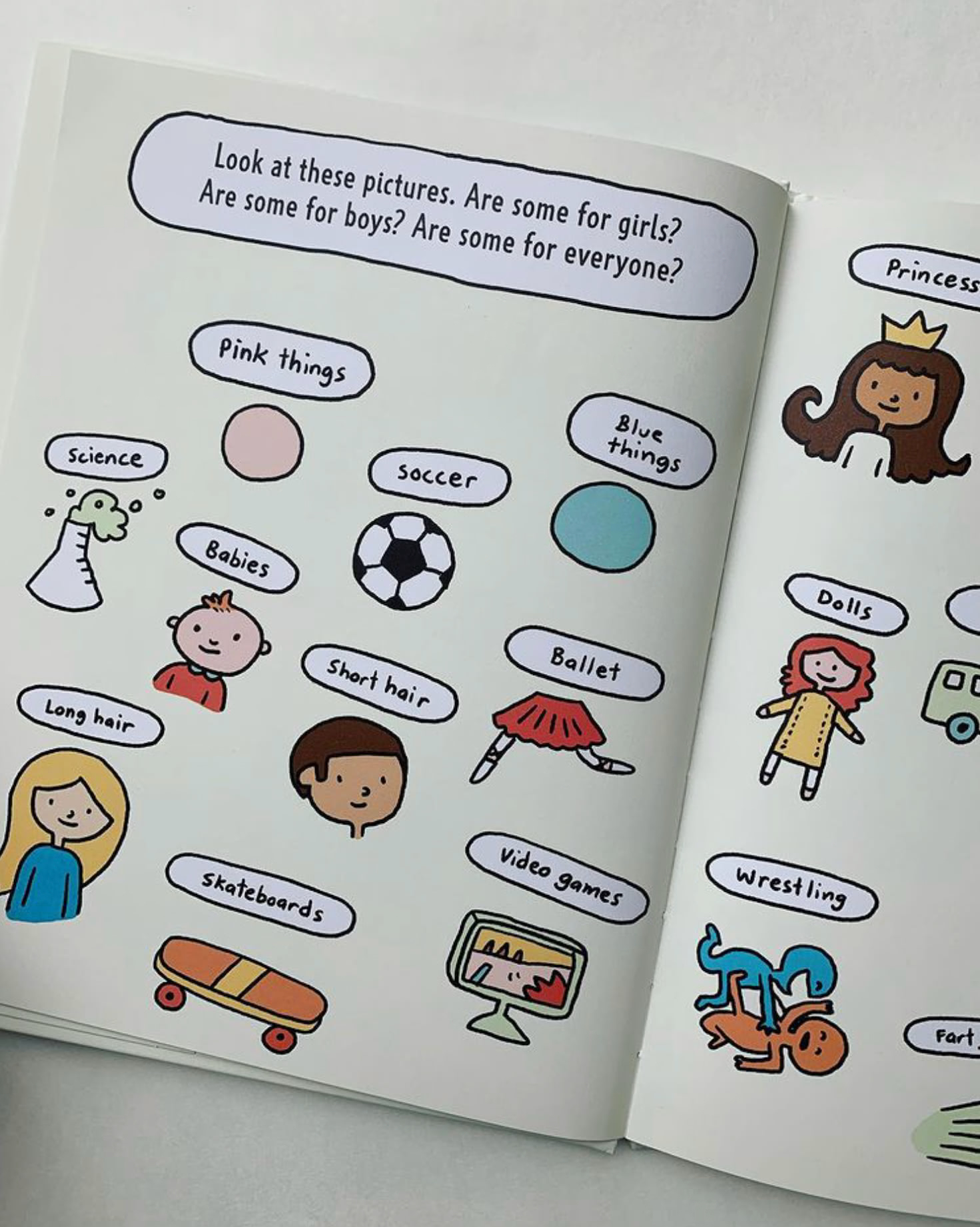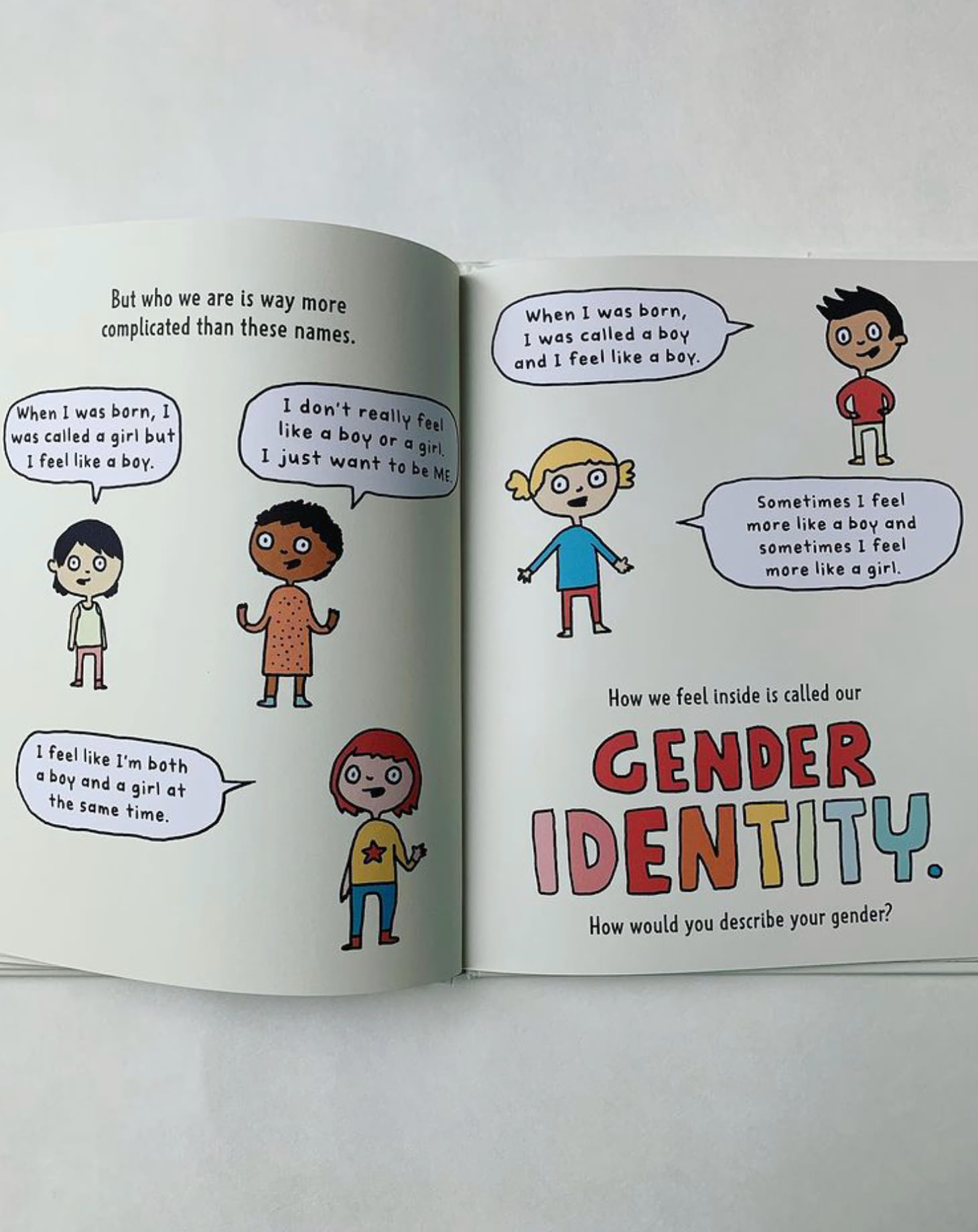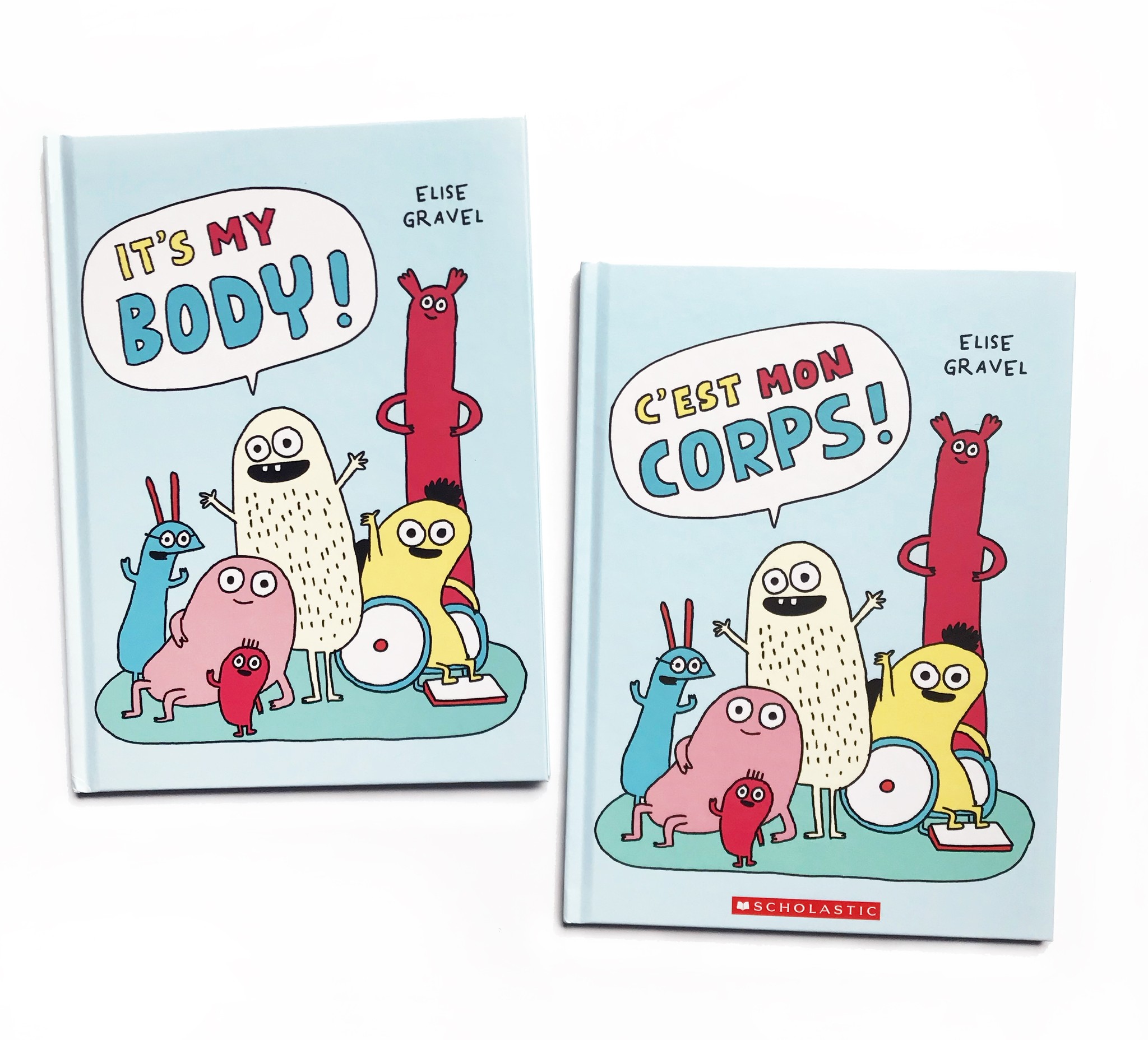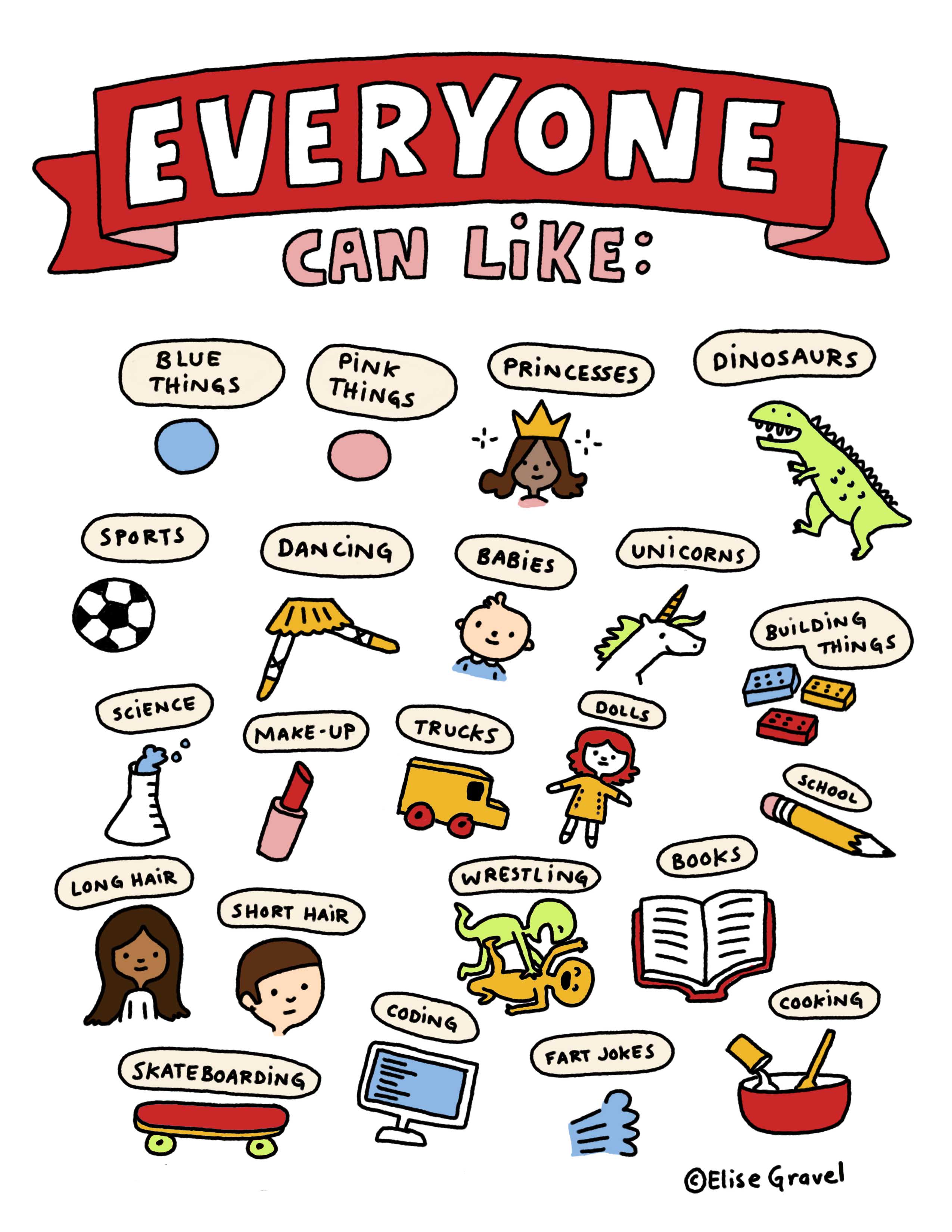Search results for “pink”
Pink, Blue and You: my new book is in stores today!
My new book is in stores today! Let’s teach our kids that their gender shouldn’t define who they are, what they like and who they love. Buy it here!
Here’s a starred review from the School Library Journal:
“In her signature style, Gravel (What Is a Refugee? and others) and Blais provide an accessible introduction to gender and gender stereotypes. Beginning with smart, open-ended questions, the authors challenge readers to think about gender stereotypes, why they exist, and if they are true or fair. The book progresses to an overview of sex versus gender, complete with helpful visual aids, an exploration of pronouns, and ultimately, a few examples of how gender is treated in different communities. At each step, the authors ask readers what they think and how they feel. This engagement, coupled with the accessible presentation of the material, makes for an excellent resource. The folks depicted throughout vary in appearance, and include many skin tones, ages, and family structures. A few folks wear hijabs, and two others use wheelchairs. Gravel’s illustrative style is wildly appealing, and the comic-style presentation helps to endear the book to readers.
Pink, Blue and You
Here’s my new book, written with Mykaell Blais. Pink, Blue and You: Questions for kids about gender stereotypes. You can preorder it HERE.
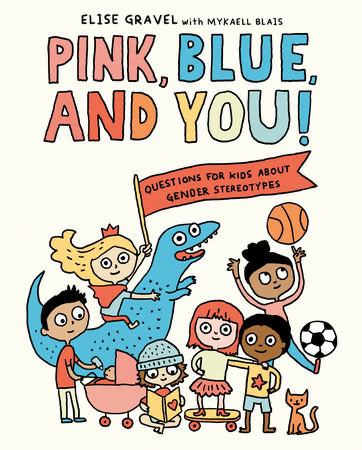
Here’s the starred review it got from the School Library Journal:
 PreS-Gr 2–In her signature style, Gravel (What Is a Refugee? and others) and Blais provide an accessible introduction to gender and gender stereotypes. Beginning with smart, open-ended questions, the authors challenge readers to think about gender stereotypes, why they exist, and if they are true or fair. The book progresses to an overview of sex versus gender, complete with helpful visual aids, an exploration of pronouns, and ultimately, a few examples of how gender is treated in different communities. At each step, the authors ask readers what they think and how they feel. This engagement, coupled with the accessible presentation of the material, makes for an excellent resource. The folks depicted throughout vary in appearance, and include many skin tones, ages, and family structures. A few folks wear hijabs, and two others use wheelchairs. Gravel’s illustrative style is wildly appealing, and the comic-style presentation helps to endear the book to readers.
PreS-Gr 2–In her signature style, Gravel (What Is a Refugee? and others) and Blais provide an accessible introduction to gender and gender stereotypes. Beginning with smart, open-ended questions, the authors challenge readers to think about gender stereotypes, why they exist, and if they are true or fair. The book progresses to an overview of sex versus gender, complete with helpful visual aids, an exploration of pronouns, and ultimately, a few examples of how gender is treated in different communities. At each step, the authors ask readers what they think and how they feel. This engagement, coupled with the accessible presentation of the material, makes for an excellent resource. The folks depicted throughout vary in appearance, and include many skin tones, ages, and family structures. A few folks wear hijabs, and two others use wheelchairs. Gravel’s illustrative style is wildly appealing, and the comic-style presentation helps to endear the book to readers.
It’s My Body, a book for kids on body diversity
From Quill and Quire:
It’s My Body! is an exuberant, kid-friendly nonfiction picture-book primer on body positivity. Simple, direct sentences celebrate “ALL KINDS” of bodies and kick-start a convivial conversation about how to be your body’s best friend.
Governor General’s Award–winning author-illustrator Elise Gravel’s signature quirky characters are in fine form. The endearingly wacky, googly-eyed monsters who populate these pages have their own unique shapes, sizes, colours, and abilities. The gallery includes a long-legged critter who looks like a pink wad of bubble gum on stilts, a round blue rascal with a toothy grin, and a reddish tube-shaped imp waving hello.
Full of pep, the cartoon illustrations showcase monsters in motion. Some of the exercising, playing, and dancing creatures use assistive devices including glasses, hearing aids, and wheelchairs, and all enjoy the feats their bodies can perform. The relatable text acknowledges the delicate mind–body connection: “Sometimes we feel good in our bodies, and sometimes we don’t.” Monsters have self-doubts too; one laments, “Are my horns too pointy?” while another confesses, “I like my eyes, but not my nose!” Combining laughs with thoughtful lessons, this robust resource also offers tips on how to treat your body with kindness and keep it “HEALTHY AND HAPPY.”
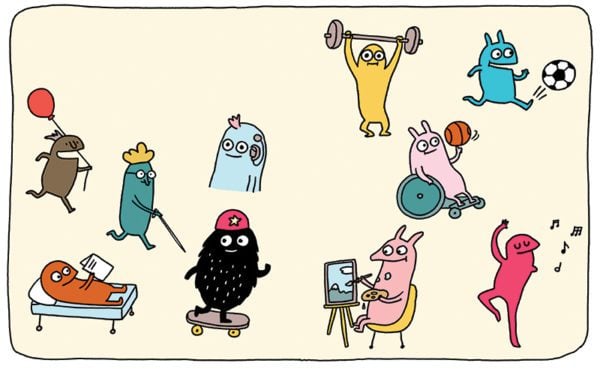
Not only is Gravel a marvellous monster maven, she is an indisputable children’s champion (honoured in 2019 with the Rights and Freedoms Award from the Quebec Commission des droits de la personne et des droits de la jeunesse). Affirmations like “Your body belongs to YOU and only you!” lead to a discussion of boundaries. Gravel is adept at breaking down big concepts into easily understood core truths: “Nobody should touch your body in ways that you don’t like. Other people have these rights too. You shouldn’t touch their bodies without asking first.” Sample social scenarios play out in the comic panels, making sense of consent and teaching kids that it is perfectly fine to choose high-fives over hugs when preferred.
With monster-sized aplomb and panache, Gravel delivers a message that can’t be heard enough: every body is worthy of love and respect.
Killer underwear invasion!
Here’s my latest book on disinformation, media literacy and conspiracy theories: Killer underwear invasion!
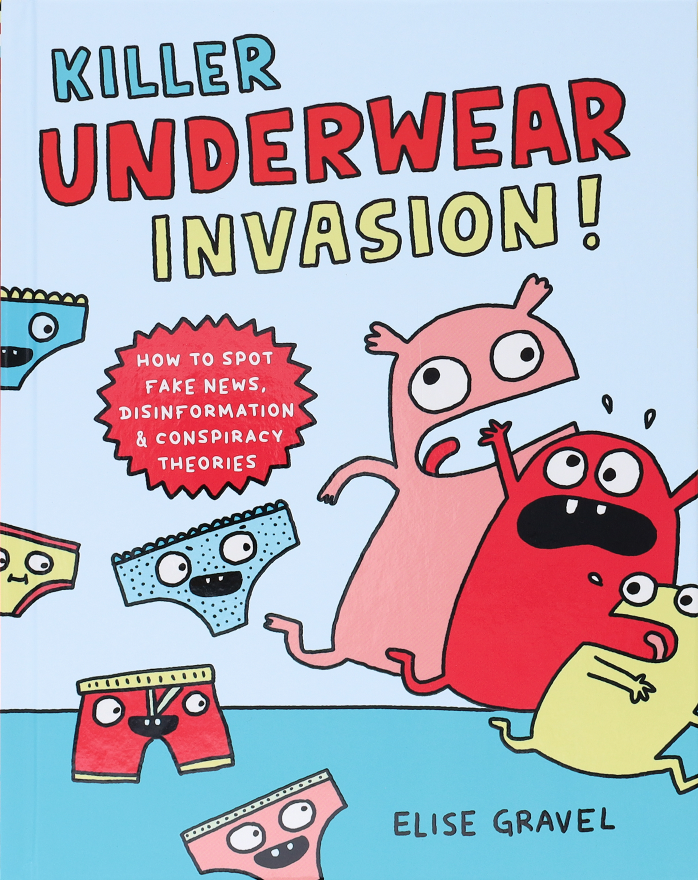

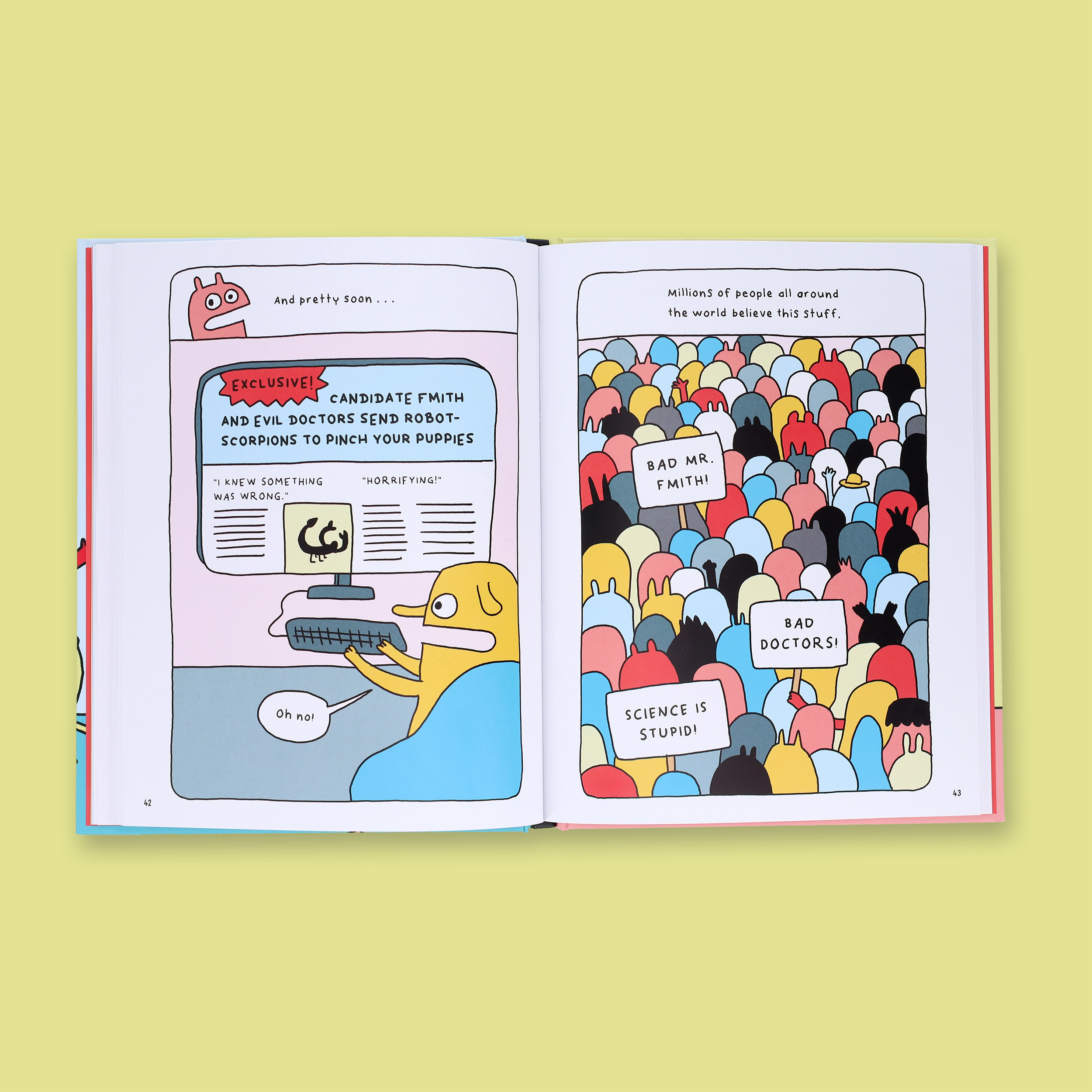
Two jellybean–shaped creatures, one blue, one pink, delve into the intricacies and duplicity behind one of the most insidious and pervasive issues of our time, and the first chapter of this middle-grade comic dives right in: “What Is Fake News?” Gravel does a fine job breaking down complex ideas, beginning with the definition of news (“information about important stuff that’s happening in the world right now”) and explaining that while disinformation is not new (“Hear ye, hear ye! An evil magician turned the king into a goat!”), the internet and other modern technologies have made it much easier to make lies look real and to intentionally spread them. The hows and whys are explored using specific, goofy fictional case studies; and people’s motives (e.g., “Reason 1: To make money…Reason 2: To make money and get famous,” etc.) are plainly laid out. Though the examples aren’t necessarily serious, the consequences are: “So far, I have given you a bunch of silly examples of fake news,” says the pink protagonist, “but fake news is not funny at all. It can actually be very dangerous.” The tone is non-blame-y of consumers (but not purveyors) of fake news, with acknowledgment of the ease of being duped (“Admit it—you’d be curious, too”) and useful advice about thinking critically, examining sources, etc. Well-delineated panel illustrations featuring blobby critters and pastel colors make these thorny concepts relatively easy to get and should leave many readers feeling empowered.- ELISSA GERSHOWITZ, Horn Book
***
This middle grade graphic nonfiction is an ingenious introduction to media literacy for kids. Using humor and super fun illustrations, author and illustrator Elise Gravel shows how kids can spot fake news and conspiracy theories. This is a must in today’s news cycle, where so much absolute nonsense is passed off as news. I used to teach introductory research and writing to college Freshmen, and if this book had existed then, I probably would’ve had them read it! At the same time, my 4-year-old enjoyed reading excerpts for the illustrations and silly jokes. It’s a really fantastic, accessible introduction that would work great in middle school classrooms. – Margaret Kingsbury, Book Riot
Everybody can like
Here’s a mini-poster I made to teach kids that their gender should not define what they like.
There is no such thing as “boy stuff” or “girl stuff”. Pink and blue are for everyone!
Parents and educators, you can download a higher resolution of this mini-poster for free here (personal and classroom use only; no commercial use allowed).
For more free printable posters, visit my boutique in the “free printable stuff” section.
If you want to license this image, contact my agent (Contact form above).
Olga 2 – We’re out of here!
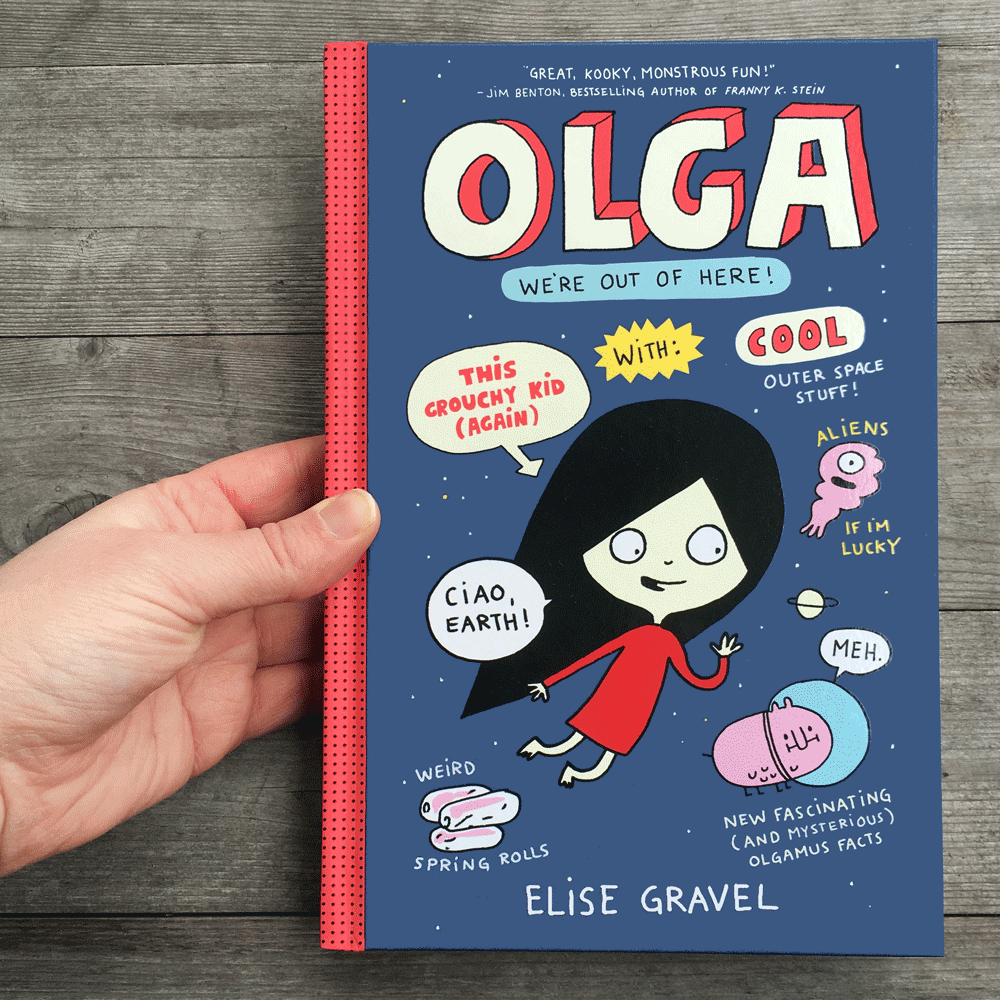
This book is now available in bookstores! I hope you’ll like it. Here’s the Kirkus review:
“In her second science-based adventure, inquisitive Olga relies on research to help determine what ails her beloved pet, Meh.
After discovering a new species—the Olgamus ridiculus—in her last adventure (Olga and the Smelly Thing from Nowhere, 2017), fact-loving and gently misanthropic Olga has decided to leave Earth with Meh, who she’s decided must come from another planet. The black-haired, pale-skinned girl gathers information about what they will need for their intergalactic journey by visiting her favorite punk-rock librarian, Ms. Swoop, amassing space facts from the internet, and learning about astronaut-appropriate fare. However, Olga soon notices that something is wrong with Meh when her companion’s usually gentle demeanor and appearance both change for the worse. Will Olga be able to find out what is wrong with her cherished Olgamus ridiculus so they can embark upon their cosmic journey? Question-loving Olga describes herself as “grouchy,” but this seems a bit unfair; Olga is a strong—and wholly likable—character who values research and fact (usually over human interaction) and is not afraid to speak her mind, whether she’s confronting the popular girls or a vainglorious veterinarian. With pleasing, pink-toned two-color illustrations in an appealing graphic-hybrid format with large, charming artwork, this should appeal to an audience who likes their protagonists to be bold, smart, and welcoming of a gross-out joke or two.
A well-wrought sophomore offering with a delightfully unconventional heroine.”
You can get the book in all bookstores!
You can find the Kirkus review HERE.
Olga #2 is coming soon!

I just got my advanced copy and it looks perfect. You can preorder it HERE, otherwise it should be in store by March 13th!
I can’t wait to know what your kids think of it. Personally, I like it even more than #1! Here’s an exerpt from the Kirkus review:
“In her second science-based adventure, inquisitive Olga relies on research to help determine what ails her beloved pet, Meh.
After discovering a new species—the Olgamus ridiculus—in her last adventure (Olga and the Smelly Thing from Nowhere, 2017), fact-loving and gently misanthropic Olga has decided to leave Earth with Meh, who she’s decided must come from another planet. The black-haired, pale-skinned girl gathers information about what they will need for their intergalactic journey by visiting her favorite punk-rock librarian, Ms. Swoop, amassing space facts from the internet, and learning about astronaut-appropriate fare. However, Olga soon notices that something is wrong with Meh when her companion’s usually gentle demeanor and appearance both change for the worse. Will Olga be able to find out what is wrong with her cherished Olgamus ridiculus so they can embark upon their cosmic journey? Question-loving Olga describes herself as “grouchy,” but this seems a bit unfair; Olga is a strong—and wholly likable—character who values research and fact (usually over human interaction) and is not afraid to speak her mind, whether she’s confronting the popular girls or a vainglorious veterinarian. With pleasing, pink-toned two-color illustrations in an appealing graphic-hybrid format with large, charming artwork, this should appeal to an audience who likes their protagonists to be bold, smart, and welcoming of a gross-out joke or two.
A well-wrought sophomore offering with a delightfully unconventional heroine. (Graphic/fiction hybrid. 7-11)”
Jessie Elliot is a big chicken
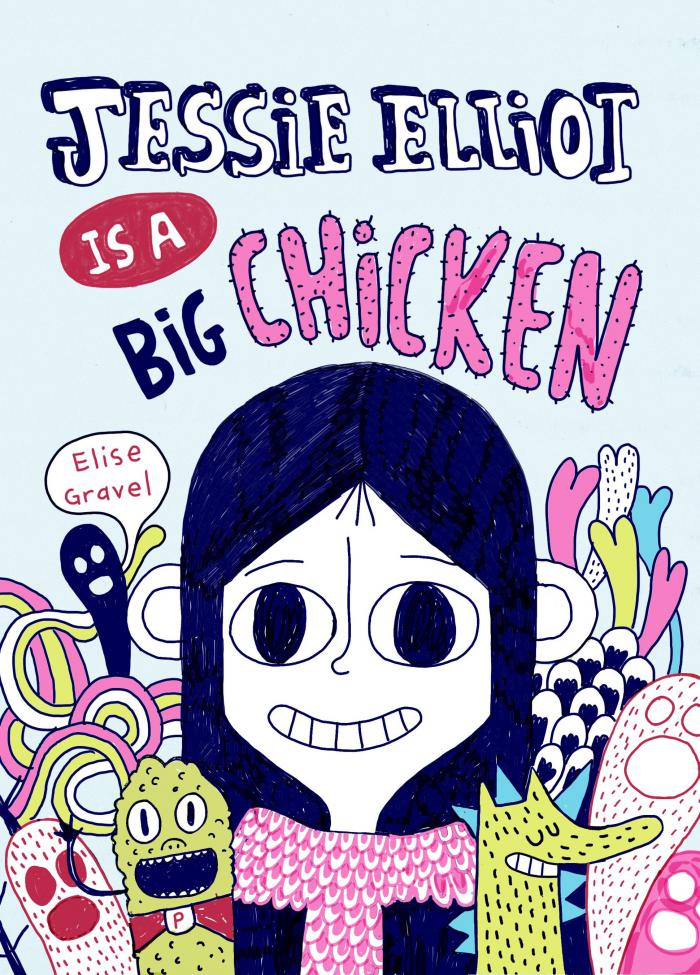
My latest book, a graphic novel about a young girl who’s scared of everything, just came out! Available in the best bookstores.
Here’s what Publisher’s Weekly has to say about it:
Jessie, a self-described “nerd extraordinaire,” candidly evaluates her life in this illustrated notebook-style novel, which is packed with screwball cartoons, doodles, lists, and comics sequences. Jessie shares her trepidation about starting high school and her disdain of the “cool” kids. Included in her hand-drawn list of “Top 10 reasons why there’s no way I’ll ever be supercool” are the facts that she reads too much, doesn’t smoke, and is “scared of everything.” Painted in bright greens, pinks, and blues, Gravel’s (How Do You Doodle?) cartoon illustrations feel ripped from the fertile mind of a creative, self-doubting teen and always amplify Jessie’s moods. Faced with the potential loss of her best friend, Jessie imagines being forced to transform herself into a pierced, cigarette-holding “Bad Jessie Doll” (“Pull the cord and she’ll use swear words!” shouts the packaging). Jessie’s exploration of her identity is relatable, and the art-heavy format, combined with all-too-common teenage worries and fears, make this a natural pick for fans of series like the Popularity Papers or Raina Telgemeier’s comics. Ages 10–14.
The Disgusting Critters
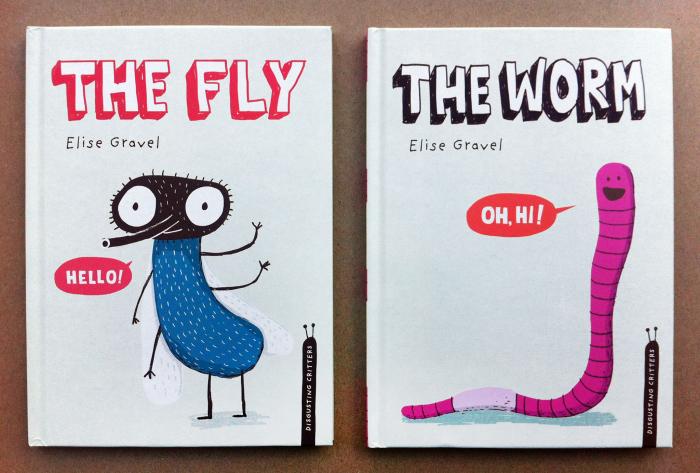
Editorial Reviews
Publishers Weekly
02/10/2014
In one of two books kicking off the aptly (and wonderfully) named Disgusting Creatures series, Gravel (How Do You Doodle?) explores the long and short of worms, with a big emphasis on humor. A pink earthworm who is prone to shouting pops up repeatedly, at one point insisting, “I am not disgusting!” after Gravel describes his species as “basically a long digestive tract inside a muscle tube. It’s that muscle tube that’s slimy and disgusting.” The boldly colored cartoons and handwritten display fonts make this a very appealing package, though the images can be at slight cross-purposes with the text (Gravel gives the friendly crew of worms eyes and smiley faces, even though readers learn halfway in that worms don’t actually have eyes). But those idiosyncrasies in no way diminish the enjoyment of the book as Gravel tightrope-walks the line between gross and funny—as in a silhouetted image of a dog that shows two parasitic white worms sitting down to a meal in its belly. Says one, “Pass the salt, please!” Simultaneously available: The Fly. Ages 6–9. (Mar.)
Kirkus Reviews
2014-01-08
The author of the rousingly revolting Day in the Office of Doctor Bugspit (2011) dishes out more dirt with this appetite-spoiling introduction to the ubiquitous fly clan. Focusing particularly on houseflies (Muscidae), Gravel ties snippets of natural science—the fly “spits or vomits a bit of digestive fluid on his meal to soften it”—to humorous scenarios (“Jonathan! Did you spit on your food?” / “Yeeeesss, Mom.” / “There’s a good boy”). The black, blue, puce and red illustrations feature bulbous, anthropomorphic figures with limp wings and tubular noses, along with the occasional accessory (the “Teenager Muscidae” sports a slouch and a sideways baseball cap; the baby has a binky). Young readers will at least come away with a thorough understanding of how unsanitary these insects are and also, perhaps, clearer pictures of their physical makeup, life cycle and even some of the differences among fly species. Published simultaneously in the Disgusting Critters series, The Worm (978-1-77049-633-0) is equally edutaining. Gross-out potential, for sure—but also likely to give larval entomologists a mild buzz. (Picture book. 5-7)

